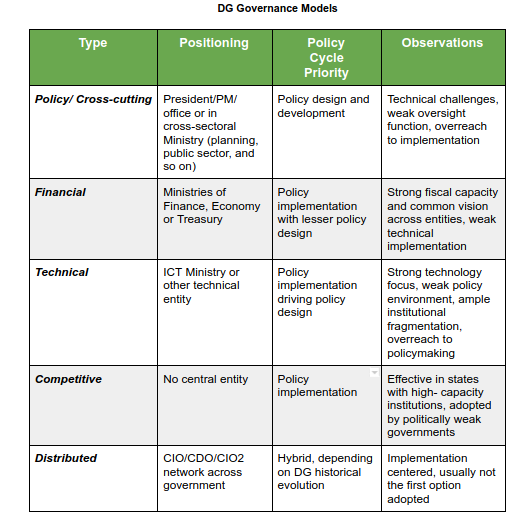Governments should fully understand the scope and reach of the various Digital Government (DG) institutional functions described in my previous post and their proper sequencing before they embark on comprehensive digital transformation processes. The policy units’ actual institutional location leading DG processes should result from the analysis of the various functions, not the starting point. Indeed, countries have deployed a wide variety of institutional arrangements while designing and implementing DG. A one size fits all approach is thus out of the question. Similarly, copying and pasting institutional design from DG lead countries or nations within similar development stages will tend to fail. Context is thus essential.
Equally important here is the distinction between policy design and development and policy implementation that are part and parcel of the policy cycle. Note, however, that not all countries have national DG policies. That has not prevented the digital transformation of the public sector.
The models presented below describe how countries have started the coordination and facilitation of DG development and implementation. Four core institutional models can be identified. They are:
- Policy or cross-cutting model. Finding an institutional space that can cohesively agglutinate the various key ministries and public entities is the core target. Two options emerge in this context. The instance is placed under the President/Primer Minister’s Office, now recognized as an international best practice, or within a ministry that already has cross-cutting mandates such as Planning or Public Administration, for example. This model is relevant to low-capacity states and/or countries facing extreme institutional fragmentation or competition and seems the best to promote comprehensive DG policy design.
- Financial or fiscal model. The distribution of financial resources to the various public entities to implement previously agreed DG priorities is the calling card for this model. Ministries of Finance or Treasury are the most obvious candidates here. This model works well in high-capacity states where fragmentation and friction within the public sector are minimal or totally absent. Policy design plays a lesser role here as the focus is more on sectoral implementation, given the public sector’s relative cohesiveness.
- Technical model. A technological centered vision of DG by key policy and decision-makers opens the door for the deployment of this model. Creating a high-level steering committee might not even be necessary as technology, not institutional modernization, dominates the scene. Natural institutional homes here are either ICT ministries or IT agencies already in place. This model usually emerges in high-capacity states or countries where the IT sector is a key priority for governments and partners in the private sector. Policy design per see takes a back seat here.
- Competitive model. No central institutional instance is envisaged in this model. Instead, each key ministry and public entity goes ahead with DG while running ahead of the rest in the process. High-capacity states or countries with fragile governments unable to address widespread institutional fragmentation are the best hosts for this model. Policy design and development might be totally absent here.
As DG development matures over the course of the years, countries have either switched between models or created new ones to cater to their own needs. The Distributed model deserves consideration as it seems to be spreading fast, sometimes even as the first option. In this model, most DG design functions are mainstream into each and every public entity involved in implementation. Chief Information Officers (CIOs), Chief Data Officers (CDOs) and, more recently, Chief Intelligence Officers (CIOs2) are the mechanisms used to deploy this model.
The CIO/CDO/CIO2 scheme entails the full professionalization of the civil service, CIO/CDO/CIO2s being professionals with graduate degrees having a deep understanding of technology management in the public sector. High-capacity states are the most frequent users of this model and low-capacity states where the governance and policy function is weak or absent.
The table below summarizes the various models, highlighting some of their potential pitfalls for each.
While sound and attractive, governments should use this set of models as a reference, not recipes. Crucial for governments is to have a deep understanding of the various DG functions and focus on local institutional realities to find the most viable path.
Cheers, Raúl

